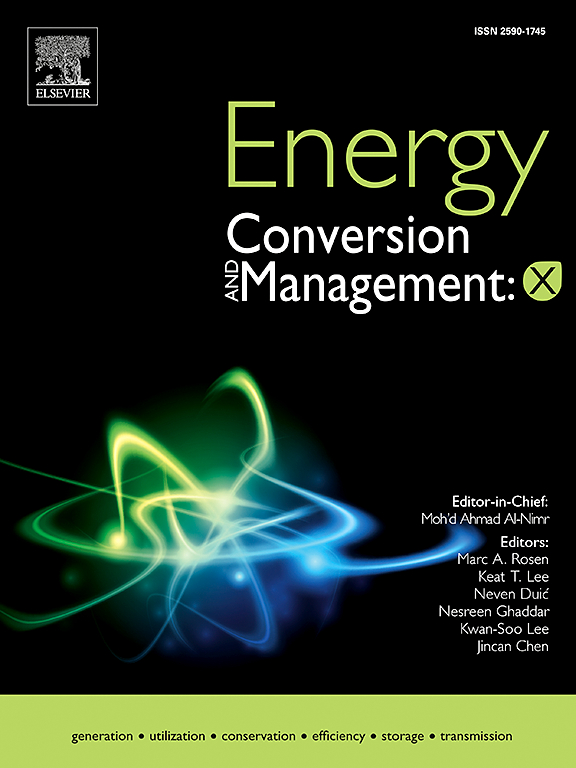海洋微藻(Isochrysis sp.)和淡水微藻(Monoraphidium c.)的热解和动力学分析
IF 7.1
Q1 ENERGY & FUELS
引用次数: 0
摘要
海洋微藻和淡水微藻生长在两种不同的生态系统中,这影响了它们的特性,因此在确定其应用之前需要注意。本文成功地揭示了两类微藻对二氧化碳(CO2)固定的热、化学和物理性质,并进行了热解过程。采用固定床热解反应器和热重分析仪对海洋微藻和淡水微藻(Isochrysis sp.和Monoraphidium c.)进行慢速热解,测定产物产率并研究其热分解剖面。热解温度分别为400、450、500、550℃,升温速率为15°Cmin - 1,氮气流量为200 ml min - 1。在TGA分析仪中,热解温度为27 ~ 800°C,加热速率为10、20和40°Cmin−1。对两种微藻样品的化学成分进行了傅里叶变换红外(FTIR)分析。在所有温度下,Isochrysis sp.的生物油产率最高(达33.9%),Monoraphidium c.的生物炭产率最高(65.78%)。从TGA热解分析来看,单孢霉属植物的主要分解发生在200-400℃之间。另一方面,Isochrysis sp.的分解曲线略慢,这可能是由于脂质组成的差异(FTIR峰2929 cm−1)。与其他几种生物质相比,所有试验的活化能都较低(33.6-40.3 kJ mol−1)。即使不添加催化剂,也不需要额外的成本,用二氧化碳固定的海洋物种也显示出有希望的结果。本文章由计算机程序翻译,如有差异,请以英文原文为准。
Pyrolysis and kinetic analysis of marine (Isochrysis sp.) and freshwater (Monoraphidium c.) microalgae
Marine and freshwater microalgae grow in two different ecosystems, which influence their properties thus requires attention prior to determining its application. This paper has successfully disclosed the thermal, chemical, and physical properties of two types of microalgae on carbon dioxide (CO2) fixation and underwent pyrolysis process. Slow pyrolysis process for marine and freshwater microalgae (Isochrysis sp. and Monoraphidium c.) was performed in the fixed bed pyrolysis reactor and TGA (thermogravimetric analyzer) to determine the product yield and study their thermal decomposition profile. The pyrolysis was completed at various temperatures (400, 450, 500, and 550 °C) at a heating rate of 15°Cmin−1 and nitrogen flow rate of 200 ml min−1. Pyrolysis in TGA analyzer ran from 27 to 800 °C at three heating rates (10, 20, and 40 °Cmin−1). For chemical composition, Fourier-transform Infrared (FTIR) analysis was performed on both microalgae samples. The highest yield (up to 33.9 %) of bio-oil was obtained from Isochrysis sp. for all temperatures while the highest average yield (65.78 %) of biochar was collected from Monoraphidium c. species. From TGA pyrolysis, the major decomposition occurred between 200–400 °C for Monoraphidium c. species. On the other hand, the decomposition profile of Isochrysis sp. was slightly slower, which may be due to the differences in lipid composition (FTIR peak 2929 cm−1). The activation energy of all tests is lower (33.6–40.3 kJ mol−1) compared to several other biomasses. Marine species fixed with CO2 showed promising results even without addition of catalyst and no additional cost needed.
求助全文
通过发布文献求助,成功后即可免费获取论文全文。
去求助
来源期刊

Energy Conversion and Management-X
Multiple-
CiteScore
8.80
自引率
3.20%
发文量
180
审稿时长
58 days
期刊介绍:
Energy Conversion and Management: X is the open access extension of the reputable journal Energy Conversion and Management, serving as a platform for interdisciplinary research on a wide array of critical energy subjects. The journal is dedicated to publishing original contributions and in-depth technical review articles that present groundbreaking research on topics spanning energy generation, utilization, conversion, storage, transmission, conservation, management, and sustainability.
The scope of Energy Conversion and Management: X encompasses various forms of energy, including mechanical, thermal, nuclear, chemical, electromagnetic, magnetic, and electric energy. It addresses all known energy resources, highlighting both conventional sources like fossil fuels and nuclear power, as well as renewable resources such as solar, biomass, hydro, wind, geothermal, and ocean energy.
 求助内容:
求助内容: 应助结果提醒方式:
应助结果提醒方式:


